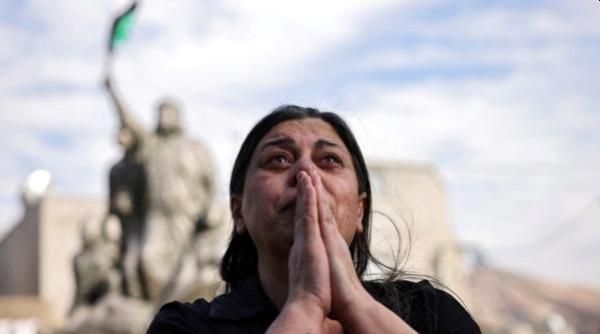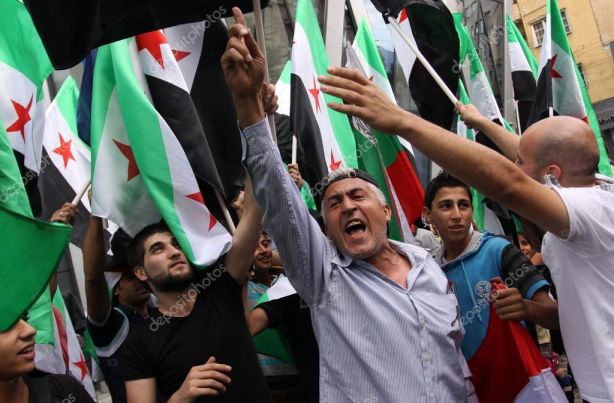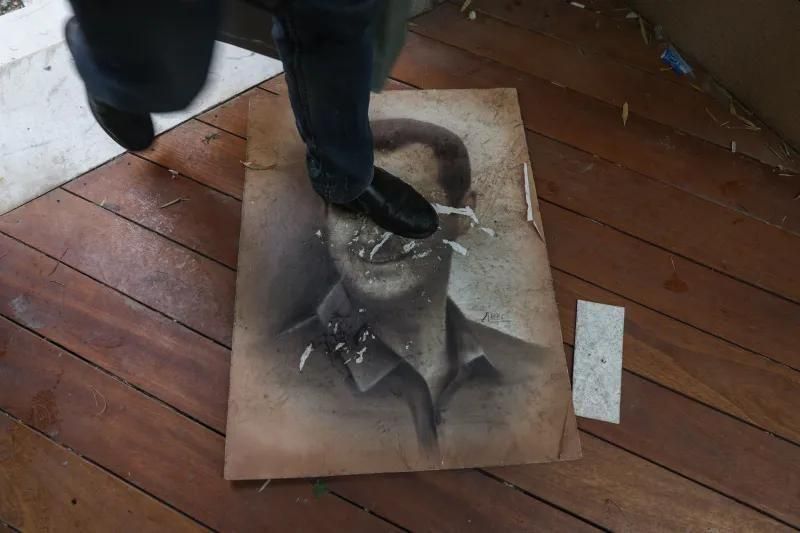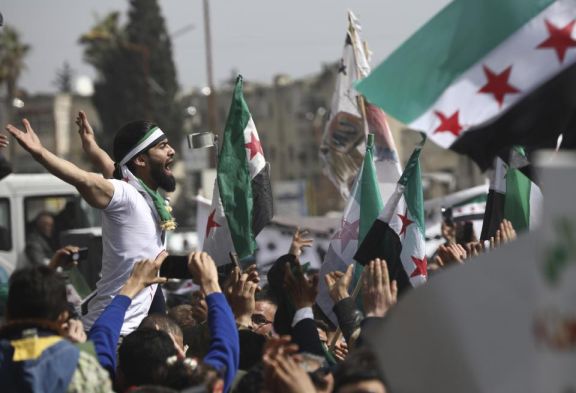By Eric Vandenbroeck and co-workers
How to Hold Syria Together in the Wake
of Assad’s Fall
Until Bashar al-Assad
fled Syria, on December 8, few countries wanted the Syrian dictator’s government
to fall. This was not because foreign governments liked Assad or approved of
the brutal way in which he reigned over Syria. Rather, they were afraid of what
might replace him: rule by extremist militants, sectarian bloodletting, and
chaos that could engulf not just Syria but much of the Middle East.
That fearful vision
was also the Assad government’s argument for itself, that its
continued survival kept anarchy and carnage at bay—and many people, including
foreign policymakers, were convinced of it. In 2015, when opposition militants
came close to toppling Assad, U.S. officials regarded the possibility of
outright rebel victory and regime collapse as tantamount to “catastrophic
success.”

Now Assad is gone.
Syrians are celebrating in the streets of Damascus, opposition groups are
attempting to organize a political transition, and the world is about to find
out what comes after the fall. Assad remained ruthless and cruel to the end,
even as he presided over an increasingly impoverished and dysfunctional state.
He leaves a shattered country in his wake, and any new government—never mind a
coalition of fractious armed opposition groups—would struggle in these
circumstances. But the poor record of Syrian rebel groups when they have ruled
significant stretches of territory also makes it difficult to be optimistic.
Still, it is in
everyone’s interest that Syria succeeds. Syrians do not want to
endure further strife and devastation, and the international community cannot
afford to see Syria fall apart. Interested countries now need to do
everything they can, including encouraging a peaceful, inclusive transition and
providing ample humanitarian and economic assistance, to ensure that the worst
fears about post-Assad Syria do not come to pass.

The Fall of Assad
In 2011, the Assad
government attempted to crush a nationwide protest movement. Those protests
became an armed rebellion, which Assad met with ferocious, escalating violence.
At several points in the ensuing war, Assad’s government seemed in real danger of
being overrun by opposition militants. Interventions by Syrian allies Iran
and Russia, however, stabilized the government militarily and enabled it
to regain ground. Between 2015 and 2020, Assad bombed opposition-controlled
enclaves across Syria into submission and retook most of the country.
The war then entered
an extended stalemate. Turkey secured several remaining
opposition-held pockets in Syria’s north, while the U.S.-backed Syrian
Democratic Forces, or SDF, controlled Syria’s east, including the country’s
most valuable agricultural and petrocarbon resources.
Thanks in part to new U.S. sanctions and neighboring Lebanon’s economic
meltdown, the whole of Syria—but government-held territory most of all—was
plunged into a deep economic crisis. Syria’s state institutions and military
progressively weakened, and the government proved too resource-starved to
stabilize and rebuild opposition-held areas it had recaptured.

But this year,
with Iran and Russia entangled in other conflicts, what remained of
Syria’s armed opposition seized the opportunity. Hayat Tahrir al-Sham—the
Syrian Liberation Group, or HTS—and other opposition factions had been
organizing for years in a Turkish-protected bastion in Syria’s northwestern
province of Idlib. On November 27, these groups launched an offensive on the
northern city of Aleppo. When they broke through the Syrian army’s defenses and
seized the city, that set off the cascading failure and collapse of Syria’s
military nationwide. HTS-led forces pushed south from Aleppo toward the
capital, Damascus, as Syrians in the country’s center and south—including in
formerly opposition-held areas—also rose up. On December 8, as opposition
factions closed in on Damascus from both north and south, Assad fled to Russia.
After more than 13 years of grinding civil war, the Assad government had
crumbled in less than two weeks.
Now, in a post-Assad
Damascus, HTS has taken the reins in attempting to manage an orderly political
transition. HTS has installed the interim Syrian Salvation Government, which it
created in Idlib, as a national transitional authority. It has also deployed
its security forces in the capital, established checkpoints on key transport
nodes across the country, and repeatedly warned triumphant opposition militants
against abusing civilians and looting.
Rebels In Charge
Many in Western media
and policy circles now evidently assume that HTS will govern Syria. Yet there
are reasons to doubt that things will be that simple. Until a few weeks ago,
HTS controlled two-thirds of a province on Syria’s rural periphery. Running all
of Syria will present a different challenge.
HTS is the latest
incarnation of the al-Nusra Front, originally the Syrian vanguard of the
Islamic State in Iraq and then al Qaeda’s Syrian affiliate. The group publicly
broke ties with al Qaeda and transnational jihadism in 2016, although it still
includes some veteran militants and foreign fighters in its ranks. It has been
designated a terrorist organization by the UN Security Council, the United
States, and other national governments.
In recent years, HTS
has worked persistently to rehabilitate its image and secure its removal from
international terrorist lists. As opposition forces marched on Damascus, HTS
and its leader, Abu Muhammad al-Jolani, attempted to project an image of seriousness
and moderation. HTS issued statements reassuring Syria’s diverse ethnic and
sectarian constituencies and various international stakeholders, while Jolani
gave interviews to Western media affirming Syria’s history of coexistence and
committing to institutional governance.
As HTS swept to
Damascus, its fighters appear to have remained relatively disciplined. Reports
of summary executions and sectarian reprisals were limited, perhaps due, in
part, to the way much of the Syrian army ceded territory without a fight. To be
sure, some retributive violence has clearly taken place, and thousands of
Syrians fearful of militant control have fled to Lebanon. But for the time
being, the victorious opposition has not unleashed a vengeful campaign against
its former foes or against communities widely associated with the old regime.
Unfortunately, HTS’s
record at the local level does not augur well for the construction of a
national government that accommodates Syria’s religious, ethnic, and political
diversity. The group has not shown any real commitment to political
pluralism in governing Idlib. HTS stage-managed some legitimating exercises to
establish its Salvation Government in Idlib, including an ostensibly inclusive
constitutional conference. Yet these were never open, participatory democratic
processes. Jolani was always in control, even though he did not hold an
official government portfolio; he was just understood to be the boss of Idlib.
Just months ago, HTS’s security apparatus violently put down protests in Idlib
demanding the release of detainees held by HTS and an end to Jolani’s rule.
HTS did manage to
create order and relative stability in Idlib. Yet it seems unlikely that HTS
will be able to reproduce its control over Idlib across the whole of Syria. The
consolidation of HTS control in Idlib was a years-long, frequently violent process,
in which HTS crushed rival opposition factions and eliminated its own
dissidents and defectors. It seems plausible that HTS could have extended its
administrative and security apparatus from Idlib to nearby Aleppo after it
seized the city. Scaling that model to cover the whole of Syria, however, seems
impossible. Syria is much larger geographically, has around ten times as many
people as Idlib, is more diverse, and is now teeming with armed men outside
HTS’s effective control. Although HTS may have fostered a strong culture of
internal discipline, the group, by one recent count, commands only 30,000 men.
That seems insufficient to govern Syria, or to control the many armed groups
that may swim in HTS’s wake.
HTS is not the
totality of Syria’s armed opposition. It was not even the whole of the armed
opposition in Idlib, where HTS marshaled allied factions that functioned as its
auxiliaries. HTS cannot control all the armed groups now active across the
country. Certainly, the factions that remobilized in the country’s center and
south over the past few weeks do not answer to Jolani.
When Syrian
opposition groups previously captured other parts of the country—including in
southern Syria, the countryside around Damascus, and in sections of northern
Syria captured by Turkish-backed groups—the result was typically arbitrary
militia rule and fratricidal infighting. Attempts to consolidate local factions
and build unifying institutions repeatedly failed. HTS succeeded in Idlib only
with a lot of time, persistence, and deadly coercion.
Many are now looking
to Turkey to use its sway over HTS and other opposition groups to help steer
Syria’s transition. But although Turkey has some influence over HTS, it does
not seem to control the group, which, for example, previously rankled the Turkish
government by seizing territory held by Turkish-backed groups in Aleppo. And
among opposition factions in northern Syria that are more wholly
Turkish-owned—on Turkey’s payroll, operating in Turkish-occupied areas that are
administered by Turkish-linked institutions—Ankara has demonstrated no ability
to impose discipline or curb abuses. Turkey has mainly just loosed these
factions on the Kurdish-led Syrian Democratic Forces, which Ankara considers an
extension of the Kurdistan Workers’ Party, a proscribed Kurdish militant group.
Even after the fall of Assad, Turkish-backed factions have continued to attack
the SDF in northern Syria.
There are reasons to
doubt the sincerity of HTS’s moderate turn. But the more immediate danger to
Syria is not Islamist extremism but the chaos that opposition victory might
unleash. There is a real risk that the situation in post-Assad Syria will spin
out of control and that the country will devolve into not only open conflict
between armed groups but also myriad individual acts of revenge and bloody
score-settling.

Set Up to Fail
Whatever dispensation
replaces Assad, this new government will not face auspicious conditions for
stability and recovery. Syria’s already crushing socioeconomic crisis seems
likely to deepen further. According to the UN, 16.7 million Syrians needed
humanitarian assistance in 2024, more than 70 percent of the country’s
population and the highest figure since the start of Syria’s war. Some 12.9
million Syrians are believed to be food insecure. State services had already
broken down before Assad’s toppling. In areas held by the Assad government, in
particular, electricity shortages had disrupted daily life and the provision of
public services such as education and running water.
HTS has limited
resources of its own. The group was able to maintain social stability in Idlib
thanks largely to internationally supported humanitarian assistance delivered
via Turkey. It remains a designated terrorist organization—it may now assume
power in an economically ruined Syria that was already extensively sanctioned.
It is not clear how a Syrian state apparatus and economy subject to numerous
overlapping sanctions regimes will work, or whether a necessary influx of donor
support will materialize. Assad’s longtime allies cannot be expected to keep
Syria afloat; already, Iran has apparently halted shipments of oil that were
critical for power generation. Humanitarian agencies have reported shortages of
essential goods and dramatic increases in food prices in major cities across
the country.
Some observers have
suggested that the fall of the Assad government could pave the way for the
return of Syrian refugees. The result, however, may be the opposite: new flows
of migration out of Syria. It was always an oversimplification to claim that
refugees who left Syria after the outbreak of the civil war in 2011 were all
fleeing the persecution of the Assad government; many were, but many others
were trying to escape general insecurity and violence, Syrian military
conscription, or socioeconomic collapse. For refugees to return in a
meaningful, sustainable way, Syria needs to be a place where people can
actually live—somewhere that is safe, with public services and reliable jobs.
Even Syrian refugees overjoyed at the fall of Assad will be unable to return
home if law and order breaks down or if they cannot find ways to support their
families.
Economic privation
could further encourage violent competition between Syrian armed groups over
territory and revenues. After more than a decade of war, these groups have
developed their own independent interests and needs. And the black markets of
Syria’s war economy will not just go away now that Assad is gone. For example,
Assad-linked actors—including groups that once opposed him—had been making
hundreds of millions of dollars trafficking illicit amphetamines. Control of
that trade now may stoke violence between competing factions.
New migration from
Syria and the resumption of internal conflict will have destabilizing effects
on Syria’s neighbors—even as those neighbors may themselves play a
destabilizing role inside Syria. Turkey has kept up a hard rhetorical line on
SDF “separatist terrorists” in Syria and has encouraged continued attacks by
its local proxies on Kurdish-led forces. Israel has bombed and destroyed Syrian
military facilities across the country and seized additional territory along
the Golan Heights. Some countries in the region, including Egypt, Jordan, and
the United Arab Emirates, are likely alarmed by the prospect of a militant
Islamist group taking power in Damascus. There is a real risk now that regional
countries could recruit local factions to secure their equities in Syria,
potentially by seizing territorial buffers along Syria’s borders. All of these
circumstances are unlikely to be conducive to a successful political
transition.
Averting Disaster
Assad will not be
missed. Under Assad and his father, Hafez, the Syrian government did heinous
things to maintain power, brutalizing and immiserating Syria’s people. The
relief of most Syrians at Assad’s departure is clear from the celebrations that
have filled the streets of Damascus and other cities and from the outpouring of
emotion at the opening of the government’s network of prisons and the
liberation of its detainees.
Now all parties need
to ensure that the darkest predictions about Assad’s fall do not come to pass
and that what replaces Assad is not just chaos and violence. Syrians themselves
will undoubtedly play the lead role in deciding the country’s future. Yet outside
countries can also help by encouraging HTS and other Syrian groups to pursue a
peaceful, maximally inclusive political transition. In parallel, donor
countries should advance a large program of humanitarian and economic
assistance for Syria, including aid for vulnerable Syrians and support for
essential services nationwide. They should provide immediate relief from
sanctions imposed on the previous Assad government, including waivers or
licenses neutralizing sanctions on state institutions such as Syria’s central
bank and on whole economic sectors. Outsiders should strongly discourage any
new factional conflict and resist the temptation to advance their own interests
by supporting one group over another.
Although some
countries may have understandable reservations about HTS, they should still
want Syria’s transition to succeed, and they absolutely should not interfere
and make it fail. The disintegration of Syria will be worse, for Syrians and
for the region. And if Syria sinks into chaos, it won’t just be a human
disaster—it will mean that the case for the Assad dictatorship has been
vindicated.
Celebrating the ouster of Syrian President Bashar
al-Assad, Latakia, Syria, December 2024

For updates click hompage here